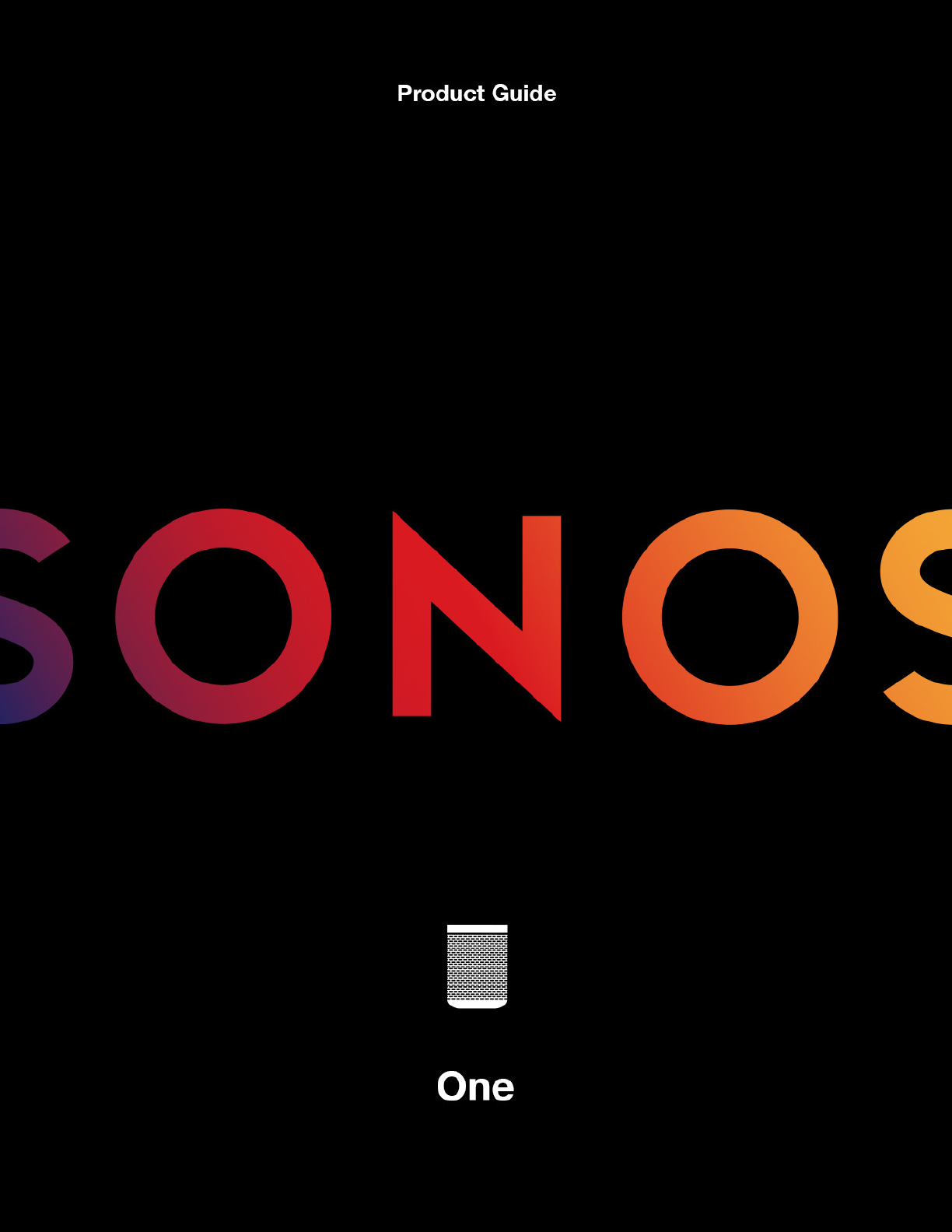
THIS DOCUMENT CONTAINS INFORMATION THAT IS SUBJECT TO CHANGE WITHOUT NOTICE.
No part of this publication may be reproduced or transmitted in any form or by any means, electronic or mechanical, including but not
limited to photocopying, recording, information retrieval systems, or computer network without the written permission of Sonos, Inc.
Sonos and all other Sonos product names and slogans are trademarks or registered trademarks of Sonos, Inc. Sonos Reg. U.S. Pat. &
Tm. Off.
Sonos products may be protected by one or more patents. Our patent-to-product information can be found here:
sonos.com/legal/patents
AirPlay®, Apple Music™, FairPlay®, iPad®, iPhone®, iPod®, Tunes®, and OS X®, are trademarks of Apple Inc., registered in the U.S.
and other countries.
“Made for iPod”, “Made for iPhone”, and “Made for iPad” mean that an electronic accessory has been designed to connect specifically to
iPod, iPhone, or iPad, respectively, and has been certified by the developer to meet Apple performance standards. Apple is not
responsible for the operation of this device or its compliance with safety and regulatory standards. Please note that the use of this
accessory with iPod, iPhone, or iPad may affect wireless performance.
Windows® is a registered trademark of Microsoft Corporation in the United States and other countries.
Android™ is a trademark of Google, Inc.
Amazon, Kindle, Kindle Fire, Echo, Alexa, and all related logos are trademarks of Amazon.com, Inc. or its affiliates.
Sonos uses MSNTP software, which was developed by N.M. Maclaren at the University of Cambridge.
© Copyright, N.M. Maclaren, 1996, 1997, 2000; © Copyright, University of Cambridge, 1996, 1997, 2000.
All other products and services mentioned may be trademarks or service marks of their respective owners.
October 2017
©2004-2017 by Sonos, Inc. All rights reserved.
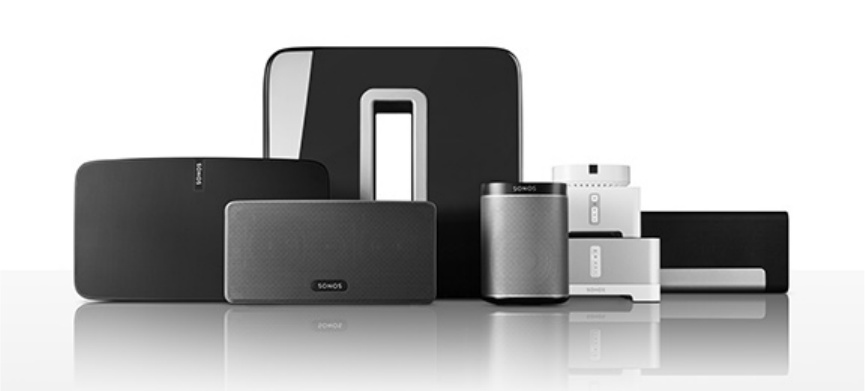
Sonos One
• Sonos One with Amazon Alexa lets you play and control your music with your voice.
• Small size makes it perfect for bookshelves, counters, and snug spaces—or mount to the wall, ceiling,
or a speaker stand.
• Illuminated LED light ensures you always know when your speaker’s microphone is on or off.
• Works seamlessly with your other Sonos products. Send songs, news, and more to speakers in other
rooms.
New to Sonos?
Just download the Sonos app and follow the setup instructions (see The Sonos app for download info).
Adding to an existing Sonos system?
Sonos can be easily expanded room by room. If you’re adding to an existing Sonos system, see Add to an
existing Sonos system for more information.
Your home network
To use the Sonos app, your device must be on the same network as Sonos. If you need help, please go to
http://faq.sonos.com/notfound.
Requirements
To access music services, Internet radio, and music stored on your computer or Network-Attached Storage
(NAS) device, make sure your network meets these requirements.
Note: Make sure your network has a high-speed Internet connection because Sonos is designed to provide you with
free, online software updates. Your Sonos system must be registered to receive these updates so be sure to
register during the setup process. We do not share your e-mail address with other companies.
Product Guide
2
• High-speed DSL/cable modem, or fiber-to-the-home broadband connection for proper playback of
music services. (If your Internet service provider only offers satellite Internet access, you may experience
playback issues due to fluctuating download rates.)
• If your modem isn’t a modem/router combination and you want to take advantage of Sonos’ automatic
online updates or use a streaming music service, you’ll need to install a wireless router before setting up
Sonos.
Note: Sonos communicates over a 2.4GHz home network supporting 802.11 b/g/n wireless technology. 802.11n only
network configurations are not supported—you can either change the router settings to 802.11
b/g/n or connect
a Sonos product to your router.
• Connect a Sonos BOOST or speaker to your router if:
• You have a larger home where the Wi-Fi performance isn’t reliable and you want to strengthen the
wireless performance of your Sonos system.
• Your Wi-Fi network is already in high demand with streaming video and web surfing and you want to
create a separate wireless network exclusively for your Sonos speakers.
• Your network is 5GHz only (not switchable to 2.4GHz).
• You have configured your router to support only 802.11n and can’t change the settings to support
802.11
b/g/n.
• For best results, you should connect the computer or NAS drive that contains your personal music library
collection to your network router using an Ethernet cable.
The Sonos app
An easy way for you to listen to all your music – in bold Sonos sound. Just get the app from the app store on
your mobile device and follow the setup instructions. Play music right away, start adding your music and voice
services, or add a music library.
Note: Get the app for your computer at www.sonos.com/support/downloads.
For the latest system requirements and compatible audio formats, go to http://faq.sonos.com/specs.
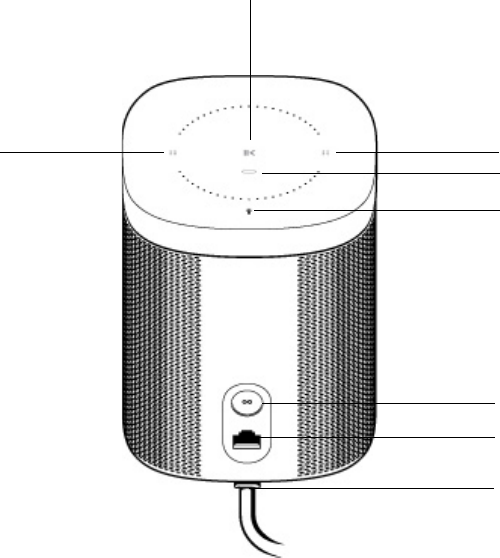
Sonos One
3
Sonos One top / back
On/Off Your Sonos system is designed to stay on. When you’re not using it,
Sonos uses minimal electricity.
• To stop the audio, touch Play/Pause in the app or on the speaker,
or ask Alexa to pause the music.
• To quickly stop the music everywhere, touch Pause All from
Rooms in the Sonos app.
Volume up (+)
Volume down (–)
Volume Up touch control is on the right; Volume Down on the left.
To change the volume quickly, touch and hold.
Status indicator light Indicates the status of your speaker.
• Normal operation: dimly lit.
• Listening or replying: full white brightness.
• Thinking: flashing white (dim to full).
For more information, see http://faq.sonos.com/led.
Join button
Ethernet port
AC power (Mains) input
Microphone indicator
Status indicator light
Volume control
Play/Pause
Volume control

Product Guide
4
Select a location
You can put your speaker just about anywhere. For maximum enjoyment, we have a few guidelines:
• Sonos One is designed to work well even when placed next to a wall or other surface. For best
performance, we recommend maintaining more than 1 inch (2.5 cm) clearance around the back of the
unit.
•It’s humidity-resistant so you can use it in the bathroom; however it is not water-resistant so don’t
position the Sonos One near water or leave it outside during a rain storm.
Add to an existing Sonos system
Once you’ve got your Sonos system set up, you can easily add more speakers any time (up to 32).
1. Attach the power cord and plug it in. Be sure to push the power cord all the way in until it’s flush with the
bottom of the unit.
2. Choose one of the following options:
• On a mobile device, open the Sonos app and tap > Settings -> Add a Player or SUB.
• On a Mac or PC, open the Sonos app and go to Manage > Add a Player or SUB.
Microphone indicator Touch to turn the microphone on and off.
• When the light is on, voice control is on and you can use voice
commands.
• When the light is off, voice control is off.
• When the light is off, you can still use voice commands. Just press
and hold the mic button to talk to Alexa. When you release, voice
control turns off again.
Play/Pause Toggles between playing and pausing the audio (restarts the same
music source unless a different source is selected.
• Press once to start or stop streaming audio
• Press and hold to add the music that’s playing in another room.
Next track
Previous track
Swipe left to right across the touch controls to get to the next track;
swipe right to left to hear the previous track.
(Next/Previous touch controls don’t work when you’re listening to a
radio station.)
Join button Press the round Join button on the back of the unit to connect.
Ethernet port You can use an Ethernet cable (supplied) to connect the Sonos One to a
router, computer, or additional network device such as a network–
attached storage (NAS) device.
AC power (mains) input
(100 – 240 VAC, 50/60 Hz)
Use only the supplied power cord to connect to a power outlet (using a
third-party power cord will void your warranty).
Insert the power cord firmly until it is flush with the bottom of the
unit.

Sonos One
5
Thick walls, 2.4 GHz cordless telephones, or the presence of other wireless devices can interfere with or block
the wireless network signals from Sonos. If you experience spotty Wi-Fi after positioning a Sonos product, try
one of these: relocate the speaker; change the wireless channel Sonos is operating on; or connect a Sonos
product to your router if your setup is currently wireless.
Add a voice service
Sonos One is a voice-enabled speaker with Amazon Alexa built right in—just enable it so you can play music
and enjoy everything else Alexa does using nothing but your Sonos One.
1. Open the Sonos app on your mobile device.
2. Ta p > Add Voice Services.
• You’ll make changes in both the Sonos and Alexa apps—we’ll guide you through it.
• You’ll need your Sonos account info. If you can’t remember it, tap > Settings -> My Sonos
Account.
Here are some things you can try with Alexa…
• Alexa, play ____ in the kitchen.
• Alexa, volume 5.
• Alexa, turn it up.
• Alexa, what’s playing?
• Alexa, play some holiday music.
Note: Over time we’ll be adding more voice services and skills. Voice control is not supported in every country yet—this
feature will be available as soon as Sonos and a voice service launch together in your region.
Tune your room with Trueplay
™
Every room is different. With Trueplay tuning, you can put your speakers wherever you want. Trueplay
analyzes room size, layout, décor, speaker placement, and any other acoustic factors that can impact sound
quality. Then it adjusts how each woofer and tweeter produces sound in that room (works on mobile devices
running iOS 8 or later).
Tap > Settings > Room Settings. Pick a room and tap Trueplay Tuning to get started.
Note: Trueplay tuning isn’t available if VoiceOver is enabled on your iOS device. If you want to tune your speakers, first
turn VoiceOver off in your device settings.
Create a stereo pair
You can group two Sonos speakers in the same room to create a wider stereo experience. In this
configuration, one speaker serves as the left channel and the other serves as the right channel.
Note: The Sonos speakers in the stereo pair must be the same model.
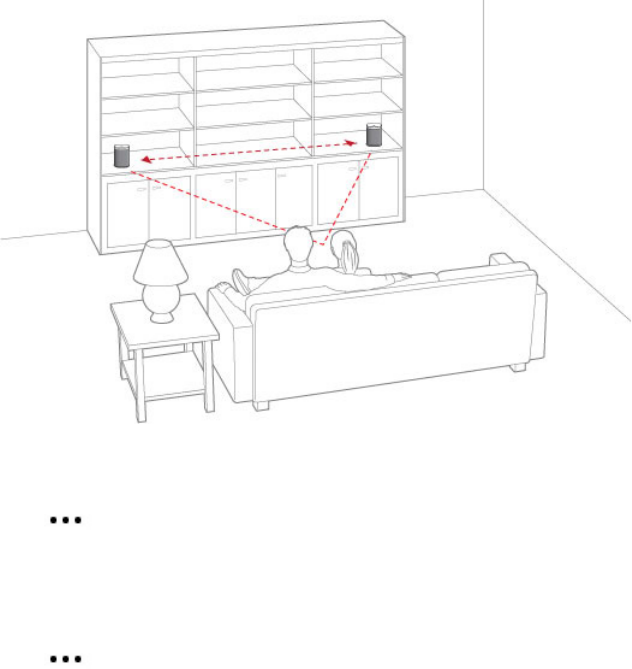
Product Guide
6
Placement information
• Place the two Sonos speakers 8 to 10 feet away from each other.
• Your favorite listening position should be 8 to 12 feet from the paired speakers—less distance will
increase bass, more distance will improve stereo imaging.
On a mobile device
1. Ta p > Settings > Room Settings.
2. Choose a speaker to pair and tap Create Stereo Pair.
After you pair your speakers, you’ll see L + R added to the end of the room name.
To separate a stereo pair:
1. Ta p > Settings > Room Settings.
2. Choose the stereo pair you want to separate (it has L + R in the room name) and tap Separate Stereo
Pair.
On a Mac or PC
1. Choose one of the following:
• On a PC, go to Manage > Settings.
• On a Mac, go to Sonos > Preferences > Room Settings.
2. Choose a speaker to pair from the Room Settings drop-down list.
3. Click Create Stereo Pair.
To separate a stereo pair:
1. Choose one of the following:
• On a PC, go to Manage > Settings.
• On a Mac, go to Sonos > Preferences > Room Settings.
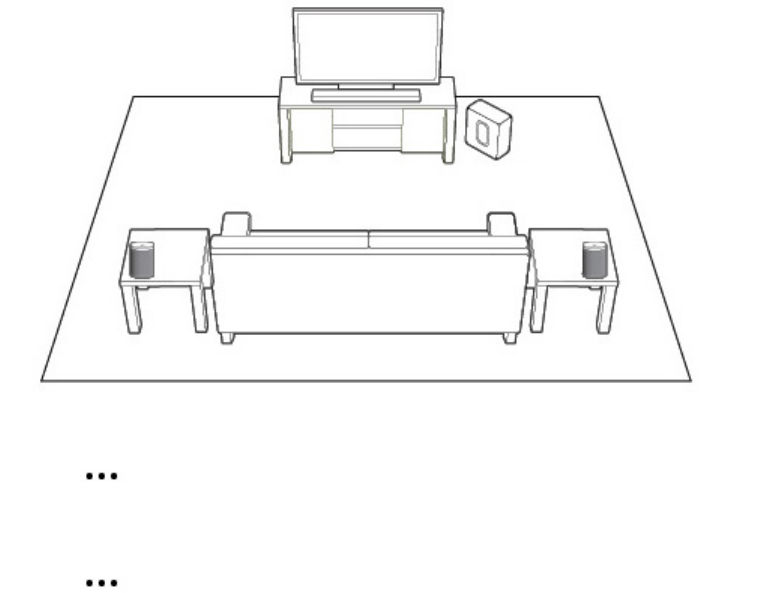
Sonos One
7
2. From the Room Settings drop-down, choose the stereo pair you want to separate (it has L + R in the
room name).
3. On the Basic tab, click Separate Stereo Pair.
Surround speakers
Add surround speakers
You can easily pair two Sonos speakers with a PLAYBAR or PLAYBASE to operate as left and right surround
channels in your home theater experience.
Note: You can use two Sonos Ones, PLAY:1s, PLAY:3s or PLAY:5s—the two speakers just have to be the same type.
Follow the instructions below to set up your surround speakers. Don’t create a room group or stereo pair
because those won’t give you the left and right surround channel functionality.
On a mobile device
1. Ta p > Settings > Room Settings.
2. Choose the room with the home theater speaker and tap Add Surrounds.
Remove surround speakers
1. Ta p > Settings > Room Settings.
2. Choose the room with the surround speakers (the room name has +LS+RS in it), and tap Remove
Surrounds.
If these speakers were already part of your Sonos system, they’ll revert back to the room name they had
before. Otherwise, they’ll appear as Unused on the Rooms menu and you can move them wherever you
want.

Product Guide
8
Change the surround settings
The default settings are determined by the calibration process. You can tweak them to suit your preferences.
1. Ta p > Settings > Room Settings.
2. Choose the room with the home theater speakers—the room name has (+LS+RS) in it.
3. Select Advanced Audio > Surround Settings.
4. Choose one of the following:
• Surrounds: Choose On or Off to turn the sound from the surround speakers on and off.
• TV Level: Drag your finger across the slider to increase or decrease the volume of the surround speakers
for playing TV audio.
• Music Level: Drag your finger across the slider to increase or decrease the volume of the surround
speakers for playing music.
• Music Playback: Choose Ambient (default; subtle, ambient sound) or Full (enables louder, full range
sound). This setting applies only to music playback, not TV audio.
• Balance Surround Speakers (iOS): Select Balance Surround Speakers and follow the prompts to
manually balance your surround speaker levels.
On a Mac or PC
1. Select Manage > Settings (PC) or Sonos > Preferences (Mac).
2. Select Room Settings if it is not already highlighted on the left.
3. Choose the room with the home theater speaker from the Room Settings drop-down list.
4. From the Basic tab, select Add Surround Speakers.
5. Follow the prompts to add first a left and then a right surround speaker.
Remove surround speakers
1. Select Manage > Settings (PC) or Sonos > Preferences (Mac).
2. Select Room Settings if it is not already highlighted on the left.
3. Choose the room the surrounds speakers are in from the Room Settings drop-down list. The room name
appears as Room (+LS+RS).
4. From the Basic tab, click Remove Surrounds. If these were newly purchased speakers, they will appear
as Unused in the Rooms pane. If these speakers existed in your household previously, they revert back to
their previous use.
Change the surround settings
The default setting is determined by the calibration process. If you want to make a change, you can follow the
steps below.
1. Select Manage > Settings (PC) or Sonos > Preferences (Mac).
2. Select Room Settings if it is not already highlighted on the left.
3. Choose the room the surrounds speakers are in from the Room Settings drop-down.
4. Select the Surrounds tab.
5. Choose one of the following:
• Surrounds: Check to turn the sound from the surround speakers on; uncheck to turn it off.
• TV Level: Click and drag the slider to increase or decrease the volume of the surround speakers for
playing TV audio.

Sonos One
9
• Music Level: Click and drag the slider to increase or decrease the volume of the surround speakers for
playing music.
• Music Playback: Choose Ambient (default; subtle, ambient sound) or Full (enables louder, full range
sound). This setting applies only to music playback, not TV audio.
Play music
Open the Sonos app and tap Browse or make a selection from the MUSIC pane on your Mac or PC.
• Radio by TuneIn. Select from more than 100,000 free internet radio stations, podcasts, and shows.
• Music services. Explore and manage your music services—add your own or try something new.
• Music stored on your mobile device. Play music you’ve downloaded to your phone or tablet.
• Music library. Play music stored on your computer or any Network-Attached Storage (NAS) device.
For a full list of music choices available in your country, go to www.sonos.com/music. For more information
about playing music, check out our mobile app product guide at www.sonos.com/guides.
Equalization settings
Sonos speakers ship with the equalization settings preset to provide the optimal playback experience. You
can change the sound settings (bass, treble, balance, or loudness) to suit your personal preferences.
1. On a mobile device, tap > Settings > Room Settings.
2. Select a room.
3. Select EQ, and then drag your finger across the sliders to make adjustments.
4. To change the Loudness setting, touch On or Off. (The loudness setting boosts certain frequencies,
including bass, to improve the sound at low volume.)
I have a new router
If you purchase a new router or change your ISP (Internet service provider), you’ll need to restart all your
Sonos products after the router is installed.
Note: If the ISP technician connects a Sonos product to the new router, you only need to restart your wireless Sonos
products.
1. Disconnect the power cord from all of your Sonos products for at least 5 seconds.
2. Reconnect them one at a time, starting with the Sonos product that is connected to your router (if one is
usually connected).
Wait for your Sonos products to restart. The status indicator light changes to solid white when the restart
is complete.

Product Guide
10
If your Sonos setup is completely wireless (you don’t keep a Sonos product connected to your router), you
will also need to change your wireless network password. Follow the steps below:
1. Temporarily connect one of your Sonos players to the new router with an Ethernet cable.
2. Ta p > Settings > Advanced Settings > Wireless Setup.
Sonos will detect your network.
3. Enter the password for your wireless network.
4. Once the password is accepted, unplug the player from your router and move it back to its original
location.
I want to change my wireless network password
If your Sonos system is set up wirelessly and you change your wireless network password, you will also need
to change it on your Sonos system.
1. Temporarily connect one of your Sonos players to your router with an Ethernet cable.
2. Choose one of the following options:
• Using the Sonos app on a mobile device, Tap > Settings > Advanced Settings > Wireless Setup.
• Using the Sonos app on a PC, go to Settings > Advanced from the Manage menu. On the General tab,
select Wireless Setup.
• Using the Sonos app on a Mac, go to Preferences > Advanced from the Sonos menu. On the General
tab, select Wireless Setup.
3. Enter the new wireless network password when prompted.
4. Once the password is accepted, you can unplug the player from your router and move it back to its
original location.
Important safety information
1. Read these instructions.
2. Keep these instructions.
3. Heed all warnings.
4. Follow all instructions.
5. Do not use this apparatus near water.
6. Clean only with dry soft cloth. Household cleaners or solvents can damage the finish on your Sonos
components. Do not vacuum the microphone area or apply air pressure.
7. Do not block any ventilation openings. Install in accordance with the manufacturer’s instructions.
8. Do not install near any heat sources such as radiators, heat registers, stoves, or other apparatus that
produce heat.

Sonos One
11
Specifications
9. Protect the power cable from being walked on or pinched, particularly at plugs, convenience
receptacles, and the point where they exit from the apparatus.
10. Only use attachments/accessories specified by the manufacturer.
11. Unplug this apparatus during lightning storms or when unused for long periods of time.
12. Refer all servicing to Sonos qualified service personnel. Servicing is required when the apparatus has
been damaged in any way, such as power-supply cable or plug is damaged, liquid has been spilled or
objects have fallen into the apparatus, the apparatus has been exposed to rain or moisture, does not
operate normally, or has been dropped.
13. The Mains plug should be readily available to disconnect the equipment.
14. Warning: To reduce the risk of fire or electric shock, do not expose this apparatus to rain or
moisture.
15. Do not expose apparatus to dripping or splashing and do not place objects filled with liquids, such as
vases, on the apparatus.
Feature Description
Audio
Amplifier Two Class-D digital amplifiers.
Tweeter One tweeter creates a crisp and accurate high frequency response.
Mid-Woofer One mid-woofer ensures the faithful playback of mid-range vocal
frequencies plus deep, rich bass.
Stereo Pair setting Turns two speakers into separate left and right channel speakers.
5.1 Home Theater Add two speakers to PLAYBAR/PLAYBASE and SUB for a true surround
sound experience.

Product Guide
12
Music
Audio Formats Supported Support for compressed MP3, AAC (without DRM), WMA without DRM
(including purchased Windows Media downloads), AAC (MPEG4), AAC+,
Ogg Vorbis, Apple Lossless, Flac (lossless) music files, as well as
uncompressed WAV and AIFF files.
Native support for 44.1kHz sample rates. Additional support for 48kHz,
32kHz, 24kHz, 22kHz, 16kHz, 11kHz, and 8kHz sample rates. MP3 supports
all rates except 11kHz and 8kHz.
Note: Apple “Fairplay”, WMA DRM and WMA Lossless formats not currently
supported. Previously purchased Apple “Fairplay” DRM-protected songs
may be upgraded.
Music Services Supported Sonos works seamlessly with most music services, including Apple
Music™, Deezer, Google Play Music, Pandora, Spotify and Radio by TuneIn,
as well as downloads from any service offering DRM-free tracks. Service
availability varies by region. For a complete list, see
http://www.sonos.com/music.
Internet Radio Supported Streaming MP3, HLS/AAC, WMA
Album Art Supported JPEG, PNG, BMP, GIF
Playlists Supported Rhapsody, iTunes, WinAmp, and Windows Media Player (.m3u, .pls, .wpl).
Networking*
Wireless Connectivity Connects to your home Wi-Fi network with any 802.11 b/g/n router.
802.11n only network configurations are not supported—you can either
change the router settings to 802.11 b/g/n or connect a Sonos product to
your router.
Ethernet Port One 10/100Mbps Ethernet port.
General
Microphones • 6 far-field microphone array.
• Audio earcon response when the microphones wake up, so you don’t
even need to look.
• Microphone LED, hard-wired to the voice microphones for extra privacy
control so you’re always aware when the microphone is active.
Power Supply Auto-switching 100 – 240 VAC, 50/60 Hz universal.
Top Panel Controls Capacitive controls for volume +/-, play/pause, next/previous track,
microphone mute.
• Tap left to lower the volume; right to turn it up.
• Swipe horizontally across the touch controls to skip to the next or
previous track.
• Tap the microphone indicator button to turn the microphone on or off.
When the light is on, voice control is on.
Feature Description
Sonos One
13
* Specifications subject to change without notice.
Product guide feedback?
We’d love to hear from you! We’ll read your feedback carefully and use it to help us improve our product
guides. Write to us at: docfeedback@sonos.com
If you’re having a problem with your Sonos system, please contact Customer Care so they can help. Email
them at http://www.sonos.com/emailsupport.
Need more help?
•Tap More > Help & Tips for simple tips for getting the most out of your speakers.
• Visit our Frequently Asked Questions (FAQ) pages at www.sonos.com/support.
• Ask us a question at http://www.sonos.com/emailsupport.
Top Pan el LE D s Status indicator
Microphone indicator
Dimensions (H x W x D) 6.36 x 4.69 x 4.69 (in) / 161.45 x 119.7 X 119.7 (mm)
Threaded mount Standard 1/4”-20 threaded mounting socket
Weight 4.08 lbs (1.85 kg)
Operating Temperature 32º to 104º F (0º to 40º C)
Storage Temperature 4º to 158º F (-20º to 70º C)
Humidity Resistant Designed to withstand high-humidity, such as in a bathroom with a running
shower. (It is not waterproof or water-resistant.)
Product Finish White with white grille; black with black grille
Feature Description